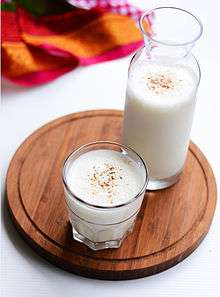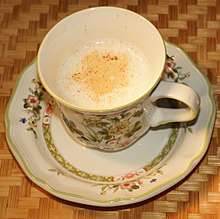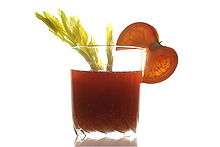List of breakfast drinks
This is a list of breakfast drinks, consisting of beverages that are or have formerly been commonly consumed at breakfast. This list consists of and is limited to very common breakfast beverages that have been denoted as such in various cultures and societies.
Common breakfast drinks
| Name | Image | Description |
|---|---|---|
| Agua Dulce | A Costa Rican breakfast drink, literally translated as sweet water, consisting of water and sugar cane molds called tapas or lids, served hot[1][2] | |
| Beer |  |
Tea replaced beer as the breakfast drink for women and children in Britain during the 18th century.[3] |
| Carnation Instant Breakfast [4] | A U.S.-based quick breakfast beverage.[5] | |
| Coffee | A common breakfast beverage[6] in many cultures. The main use of coffee is for waking up due to its high caffeine content.[7] | |
| Energy drink | .jpg) |
Similar to coffee, they are used to wake up and be alert due to their high caffeine content.[8] However, frequent energy drink usage is associated with stress, anxiety, and depression.[9] |
| Grapefruit juice | A fruit juice that is sometimes consumed at breakfast in the United States.[10][11] | |
| Hot chocolate [12] |  |
A common breakfast drink in Europe[lower-alpha 1] |
| Instant breakfast [14] | A powdered drink mix typically mixed with milk. | |
| Lassi [15] |  |
A yoghourt drink which is popular at breakfast in India in the summer.[15] |
| Milk |  |
A traditional breakfast beverage in the United States.[16] |
| Orange juice |  |
A common breakfast beverage in North America.[17][18] |
| Salep, or saloop |  |
A primary breakfast drink in the Ottoman Empire before tea and coffee rose to prominence.[1] |
| Sarabba | An Indonesian breakfast drink that is similar to chai[1] | |
| Soy milk | .jpg) |
Consumed in China as a hot breakfast drink.[19] |
| Tea | In some cultures, tea is consumed in the morning or as a part of breakfast. For example, in Fijian cuisine, tea is consumed in the morning in tin bowls.[20] In Tajikistan, a tea named choi is consumed at breakfast.[20] Tea is also consumed during breakfast in Eritrea.[20] Porcelain tea service basins for the consumption of tea at breakfast exist.[21] | |
| Tomato juice [22] |  |
In the United States, mass-produced tomato juice began to be marketed in the mid-1920s, and it became a popular breakfast drink.[22] |
| Water | Water hydrates the body and may suppress appetite.[23] Drinking water immediately upon waking is a common practice among Japanese women. |
See also
Notes
References
- 1 2 3 Stevens, Ashlie (February 18, 2016). "6 Hot Breakfast Drinks From Around The World". Eater. Vox Media. Retrieved July 24, 2018.
- ↑ D'Avanzo, Carolyn (2008). Mosby's Pocket Guide to Cultural Health Assessment - E-Book. Elsevier Health Sciences. ISBN 0323086047. Retrieved 25 July 2018.
- ↑ Professor John Burnett (2012), Liquid Pleasures: A Social History of Drinks in Modern Britain, Routledge, p. 179, ISBN 9781134788804
- ↑ Smith, A.F. (2007). The Oxford Companion to American Food and Drink. Oxford Companions. Oxford University Press, USA. p. pt94-95. ISBN 978-0-19-530796-2. Retrieved August 4, 2018.
- ↑ Lantos, G.P. (2010). Consumer Behavior in Action. M. E. Sharpe Incorporated. p. 45. ISBN 978-0-7656-2911-1. Retrieved August 5, 2018.
- ↑ Kushner, M. (2006). The Truth about Caffeine: How Companies that Promote it Deceive Us and what We Can Do about it. SCR Books. p. 28. ISBN 978-0-9747582-1-3. Retrieved August 5, 2018.
- ↑ "Effects Of Caffeine On Brain Function: How Drinking Coffee Wakes You Up". Medical Daily. 25 July 2017. Retrieved 6 August 2018.
- ↑ Richardson, Hannah (1 October 2013). "Pupils breakfasting on energy drinks". BBC News. Retrieved 6 August 2018.
- ↑ Richards, Gareth; Smith, Andrew P. (2016). "Breakfast and Energy Drink Consumption in Secondary School Children: Breakfast Omission, in Isolation or in Combination with Frequent Energy Drink Use, is Associated with Stress, Anxiety, and Depression Cross-Sectionally, but not at 6-Month Follow-Up". Frontiers in Psychology. doi:10.3389/fpsyg.2016.00106. Retrieved 6 August 2018.
- ↑ Anderson, H.A. (2013). Breakfast: A History. The Meals Series. AltaMira Press. p. 90. ISBN 978-0-7591-2165-2. Retrieved July 25, 2018.
- ↑ Hill, Napoleon (2005). Think and Grow Rich. Penguin. ISBN 9781440628238. Retrieved 25 July 2018.
- ↑ Report. Bulletin (Connecticut Agricultural Experiment Station). The State. 1903. p. 254. Retrieved August 4, 2018.
- ↑ Arndt, A. (2017). Seasoning Savvy: How to Cook with Herbs, Spices, and Other Flavorings. CRC Press. p. pt85. ISBN 978-1-351-99155-1. Retrieved August 4, 2018.
- ↑ Sengupta, S. (2005). Brand Positioning: Strategies for Competitive Advantage. McGraw-Hill Companies,Incorporated. p. 5. ISBN 978-0-07-058159-3. Retrieved August 5, 2018.
- 1 2 Camellia Panjabi (1995), The Great Curries of India, Simon and Schuster, p. 188, ISBN 9780684803838
- ↑ Robertson, C. (2002). Safety, Nutrition, and Health in Child Care. Delmar Thomson Learning. p. 315. ISBN 978-0-7668-3845-1. Retrieved August 5, 2018.
- ↑ Gay, K. (1996). Encyclopedia of North American eating & drinking traditions, customs & rituals. ABC-CLIO. p. 184. ISBN 978-0-87436-756-0. Retrieved August 5, 2018.
- ↑ Anderson, H.A. (2013). Breakfast: A History. The Meals Series. AltaMira Press. p. 90. ISBN 978-0-7591-2165-2. Retrieved August 5, 2018.
- ↑ Vegetarian Times. Active Interest Media, Inc. p. 20. Retrieved August 4, 2018.
- 1 2 3 Snodgrass, M.E. (2004). Ency Kitchen History (in German). Taylor & Francis. p. 992. ISBN 978-0-203-31917-8. Retrieved August 5, 2018.
- ↑ Lippert, C.B. (1987). Eighteenth-century English Porcelain in the Collection of the Indianapolis Museum of Art. Indianapolis Museum of Art. p. 191. ISBN 978-0-936260-11-2. Retrieved August 5, 2018.
- 1 2 Nineteen Twenties - Kathleen Morgan Drowne, Patrick Huber - Google Books
- ↑ "Killer morning habit: Drink 16oz of water, right after you wake up". A Life of Productivity. 28 November 2013. Retrieved 6 August 2018.
Further reading
- Hyatt-Woolf, C. (1897). Food Frauds and Foods that Feed: Being an Exposure of Some Commercial Shams, and Some Advice on what to Eat, Etc. Simpkin, Marshall, Hamilton & Kent. p. 40-53. Retrieved July 18, 2018.
External links
This article is issued from
Wikipedia.
The text is licensed under Creative Commons - Attribution - Sharealike.
Additional terms may apply for the media files.